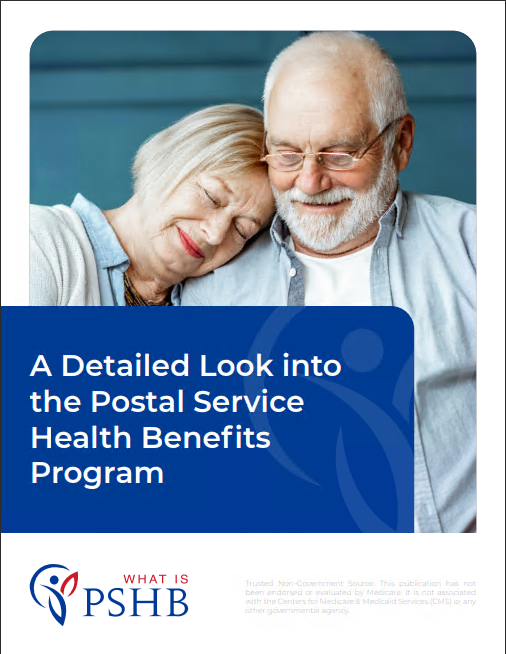Key Takeaways
-
If you’re a retired USPS employee, you may be eligible for both Medicare and the Postal Service Health Benefits (PSHB) Program. Understanding how these two programs interact can help you maximize your healthcare coverage while minimizing costs.
-
Medicare enrollment can impact your PSHB plan choices and out-of-pocket expenses. Knowing when to sign up and how to coordinate benefits ensures you don’t face unexpected gaps in coverage.
Understanding Medicare and PSHB Eligibility
As a USPS retiree, you may qualify for both Medicare and PSHB coverage. Medicare typically becomes available at age 65, but your PSHB eligibility depends on your employment history and whether you retired before or after the transition from FEHB to PSHB in 2025.
Medicare Eligibility
You become eligible for Medicare at age 65 if you have at least 40 quarters of work history. You may also qualify earlier due to disability or specific medical conditions. Medicare consists of several parts:
-
Part A (Hospital Insurance): Covers inpatient hospital stays, skilled nursing facilities, and hospice care.
-
Part B (Medical Insurance): Covers doctor visits, outpatient care, and preventive services.
-
Part D (Prescription Drug Coverage): Helps pay for prescription medications.
Medicare beneficiaries often find that enrollment in these parts impacts their existing health coverage. This is why it’s important to understand how your PSHB plan integrates with Medicare.
PSHB Eligibility
The PSHB program replaces the Federal Employees Health Benefits (FEHB) program for Postal Service employees and retirees starting in 2025. To continue coverage under PSHB in retirement, you must have been enrolled while actively employed or as an annuitant.
Unlike Medicare, which requires enrollment at specific times, PSHB allows you to maintain coverage as long as you meet the program’s requirements. However, once you become eligible for Medicare, understanding how these two programs work together becomes crucial for optimizing your healthcare.
How Medicare Works with PSHB
Once you enroll in Medicare, it coordinates with your PSHB plan to determine which program pays first. Understanding this interaction ensures you receive the most comprehensive coverage available.
Coordination of Benefits
PSHB remains your primary coverage until you enroll in Medicare. Once enrolled:
-
Medicare becomes the primary payer for most healthcare services.
-
PSHB serves as secondary insurance, covering costs Medicare doesn’t fully pay.
Your plan may also offer additional benefits that enhance Medicare coverage, such as lower copayments, waived deductibles, or cost-sharing reductions.
Impact on Out-of-Pocket Costs
Having both Medicare and PSHB can reduce your overall healthcare costs. Many PSHB plans waive deductibles and coinsurance when Medicare Parts A and B are active. This can significantly lower:
-
Hospital stay costs
-
Doctor visit copayments
-
Specialist care expenses
-
Durable medical equipment costs
-
Preventive care expenses
Additionally, some PSHB plans may offer reimbursement programs or incentives for Medicare enrollees. Checking your plan details annually ensures you are taking full advantage of cost-saving opportunities.
Should You Enroll in Medicare Part B?
One of the biggest decisions you’ll face is whether to enroll in Medicare Part B when you become eligible. While Part A is typically premium-free, Part B comes with a monthly premium. Your choice affects your PSHB benefits and overall healthcare expenses.
Why Enrolling in Part B Might Be Beneficial
-
Lower Cost-Sharing: Some PSHB plans waive deductibles and coinsurance when Medicare Part B is active.
-
More Provider Options: Medicare may give you access to more doctors, especially if you travel frequently or live outside your PSHB plan’s network.
-
Future Coverage Security: If you delay enrollment in Part B, you may face late penalties if you decide to sign up later.
-
Improved Financial Protection: Since Medicare helps cover significant portions of hospital and outpatient expenses, having Part B may reduce your risk of unexpected high costs.
When Skipping Part B Could Make Sense
-
High PSHB Coverage Levels: If your PSHB plan already provides comprehensive coverage, you might not see significant savings from adding Part B.
-
Budget Considerations: The Part B premium could be an additional expense without much financial benefit if your PSHB plan already meets your healthcare needs.
-
Minimal Healthcare Needs: If you rarely visit doctors or require medical services, the additional cost of Part B may not be necessary at this stage.
Prescription Drug Coverage: Medicare Part D vs. PSHB
PSHB plans include prescription drug coverage, so you may not need to enroll in Medicare Part D. However, Medicare drug plans may provide additional coverage for certain medications.
Comparing Prescription Benefits
-
PSHB Drug Coverage: Integrated into your health plan, covering a wide range of medications.
-
Medicare Part D: Available separately, with standalone plans that might offer better pricing for specific drugs.
Since PSHB coverage typically meets prescription drug needs, most enrollees do not need to sign up for Medicare Part D. However, it’s always a good idea to compare coverage details, especially if your medication needs change over time.
Key Enrollment Deadlines You Need to Know
Navigating Medicare and PSHB enrollment timelines is essential to avoiding penalties and ensuring continuous coverage.
Medicare Enrollment Periods
-
Initial Enrollment Period (IEP): Begins three months before your 65th birthday and extends three months after.
-
General Enrollment Period (GEP): Runs from January 1 to March 31 each year if you missed IEP.
-
Special Enrollment Period (SEP): Available if you delayed Medicare due to active employment but now need coverage.
PSHB Enrollment Considerations
-
Open Season (November-December): Allows retirees to review or change PSHB plans.
-
Qualifying Life Events (QLEs): Let you adjust PSHB coverage outside of Open Season if you experience events like retirement or changes in Medicare enrollment.
Common Mistakes to Avoid When Managing Both Plans
Understanding how Medicare and PSHB interact can help you avoid costly errors. Here are some common pitfalls to watch for:
1. Missing Medicare Enrollment Deadlines
Delaying Medicare enrollment beyond your initial window can result in late penalties, increasing your costs permanently.
2. Assuming PSHB Covers Everything Without Medicare
Some PSHB plans require you to enroll in Medicare to access certain cost-saving benefits. Review your plan details carefully.
3. Overpaying for Duplicate Coverage
If your PSHB plan already offers strong benefits, you may not need Medicare Part B or Part D. Compare costs before enrolling in extra coverage.
4. Ignoring Changes in Annual Open Season
PSHB and Medicare benefits change yearly. Reviewing your options each Open Season ensures you have the best coverage for your needs.
5. Not Reviewing Prescription Drug Coverage
Since medication coverage varies, checking formularies annually can prevent unexpected costs and coverage gaps.
Making the Most of Your Coverage
By understanding how Medicare and PSHB work together, you can optimize your healthcare coverage and minimize out-of-pocket costs. The key is to:
-
Know your enrollment deadlines.
-
Compare costs and benefits.
-
Take advantage of PSHB and Medicare coordination to reduce expenses.
-
Review your coverage annually to ensure it meets your needs.
If you’re unsure which choices are best for your situation, get in touch with a licensed agent listed on this website for professional advice.










